Yamaha XVZ13TFY, XVZ13TFC, XVZ13TFSY, XVZ13TFSC, XVZ13TFYC Owner's Manual
...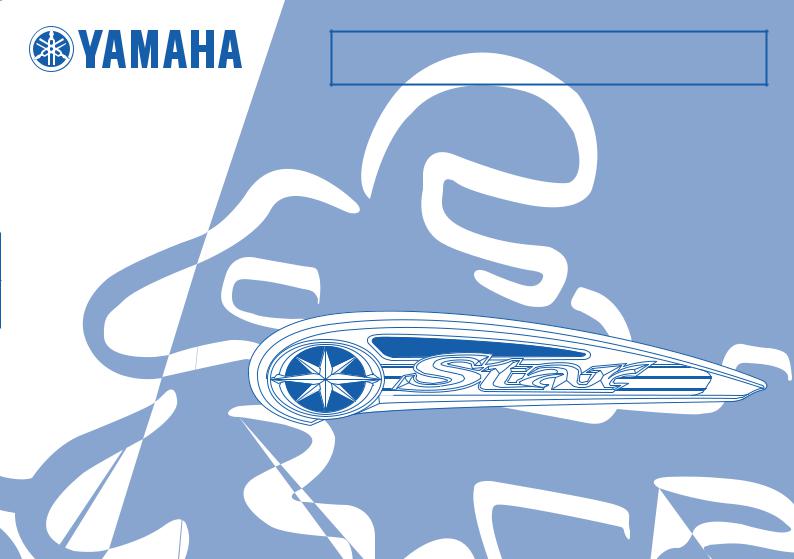
 Read this manual carefully before operating this vehicle.
Read this manual carefully before operating this vehicle.
OWNER’S MANUAL
XVZ13TFY(C)
XVZ13TFSY(C)
LIT-11626-22-50 |
2C9-28199-13 |
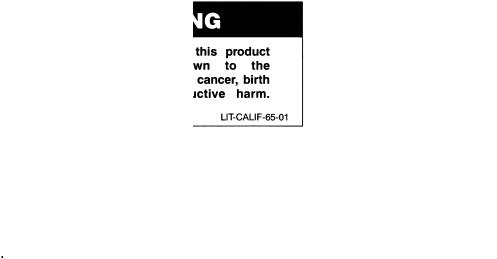
EAU10042
 Read this manual carefully before operating this vehicle. This manual should stay with this vehicle if it is sold.
Read this manual carefully before operating this vehicle. This manual should stay with this vehicle if it is sold.

INTRODUCTION
EAU10081
Congratulations on your purchase of the Yamaha Royal Star™ VENTURE®. This model is the result of Yamaha’s vast experience in the production of fine sporting, touring, and pacesetting racing machines. It represents the high degree of craftsmanship and reliability that have made Yamaha a leader in these fields.
This manual will give you an understanding of the operation, inspection, and basic maintenance of this motorcycle. If you have any questions concerning the operation or maintenance of your motorcycle, please consult a Yamaha dealer.
The design and manufacture of this Yamaha motorcycle fully comply with the emissions standards for clean air applicable at the date of manufacture. Yamaha has met these standards without reducing the performance or economy of operation of the motorcycle. To maintain these high standards, it is important that you and your Yamaha dealer pay close attention to the recommended maintenance schedules and operating instructions contained within this manual.
Yamaha continually seeks advancements in product design and quality. Therefore, while this manual contains the most current product information available at the time of printing, there may be minor discrepancies between your motorcycle and this manual. If there is any question concerning this manual, please consult a Yamaha dealer.
EWA10011
 WARNING
WARNING
Please read this manual and the “YOU AND YOUR MOTORCYCLE: RIDING TIPS” booklet carefully before operating this motorcycle. Do not attempt to operate this motorcycle until you have attained adequate knowledge of its controls and operating features. Regular inspections and careful maintenance, along with good operating techniques, will help ensure that you safely enjoy the capabilities and reliability of this motorcycle.

IMPORTANT MANUAL INFORMATION
EAU10132
Particularly important information is distinguished in this manual by the following notations:
This is the safety alert symbol. It is used to alert you to potential personal injury hazards. Obey all safety messages that follow this symbol to avoid possible injury or death.
WARNING |
A WARNING indicates a hazardous situation which, if not avoided, could result in |
|
death or serious injury. |
||
|
||
NOTICE |
A NOTICE indicates special precautions that must be taken to avoid damage to the |
|
vehicle or other property. |
||
|
TIP |
A TIP provides key information to make procedures easier or clearer. |
|
|

IMPORTANT MANUAL INFORMATION
EAU10193
XVZ13TFY(C)/XVZ13TFSY(C)
OWNER’S MANUAL
©2008 by Yamaha Motor Corporation, U.S.A. 1st edition, May 2008
All rights reserved.
Any reprinting or unauthorized use without the written permission of Yamaha Motor Corporation, U.S.A. is expressly prohibited.
Printed in Japan.
P/N LIT-11626-22-50

TABLE OF CONTENTS
LOCATION OF IMPORTANT |
|
LABELS ............................................. |
1-1 |
SAFETY INFORMATION .................. |
2-1 |
DESCRIPTION .................................. |
3-1 |
Left view .......................................... |
3-1 |
Right view ........................................ |
3-2 |
Controls and instruments................. |
3-3 |
INSTRUMENT AND CONTROL |
|
FUNCTIONS ....................................... |
4-1 |
Main switch/steering lock ................ |
4-1 |
Indicator and warning lights ............ |
4-2 |
Speedometer unit ........................... |
4-4 |
Cruise control system ..................... |
4-5 |
Self-diagnosis device ...................... |
4-7 |
Handlebar switches ........................ |
4-7 |
Clutch lever ..................................... |
4-9 |
Shift pedal ....................................... |
4-9 |
Brake lever ................................... |
4-10 |
Brake pedal .................................. |
4-10 |
Fuel tank cap ................................ |
4-10 |
Fuel ............................................... |
4-11 |
Fuel cock ...................................... |
4-12 |
Starter (choke) knob ..................... |
4-13 |
Locking the steering with a |
|
padlock ...................................... |
4-14 |
Rider seat ..................................... |
4-14 |
Helmet holders ............................. |
4-15 |
Sidecases and travel trunk ........... |
4-15 |
Adjusting the front fork ................. |
4-17 |
Adjusting the shock absorber |
|
assembly ................................... |
4-18 |
Sidestand ..................................... |
4-19 |
Ignition circuit cut-off system ........ |
4-20 |
Auxiliary DC jack and |
|
connector .................................. |
4-22 |
AUDIO SYSTEM AND CB RADIO .... |
5-1 |
Location of parts ............................. |
5-1 |
Headsets (optional) ........................ |
5-2 |
Control unit ..................................... |
5-3 |
Making basic settings ..................... |
5-4 |
Making mode settings .................... |
5-6 |
Cassette deck operation ................ |
5-9 |
Radio operation ............................ |
5-11 |
Optional CD changer operation .... |
5-15 |
CB radio operation ....................... |
5-16 |
Auxiliary audio source |
|
operation ................................... |
5-20 |
FOR YOUR SAFETY – |
|
PRE-OPERATION CHECKS ............. |
6-1 |
Pre-operation check list .................. |
6-2 |
OPERATION AND IMPORTANT |
|
RIDING POINTS................................. |
7-1 |
Starting and warming up a cold |
|
engine ......................................... |
7-1 |
Starting a warm engine .................. |
7-2 |
Shifting ........................................... |
7-3 |
Engine break-in .............................. |
7-4 |
Parking ........................................... |
7-5 |
PERIODIC MAINTENANCE AND |
|
ADJUSTMENT................................... |
8-1 |
Owner’s tool kit .............................. |
8-2 |
Periodic maintenance chart for |
|
the emission control system ....... |
8-3 |
General maintenance and |
|
lubrication chart .......................... |
8-4 |
Removing and installing cowlings |
|
and panels .................................. |
8-8 |
Checking the spark plugs ............ |
8-11 |
Canister (for California only) ........ |
8-12 |
Engine oil and oil filter cartridge ... |
8-12 |
Final gear oil ................................ |
8-15 |
Coolant ........................................ |
8-17 |
Cleaning the air filter elements .... |
8-18 |
Carburetors .................................. |
8-20 |
Checking the engine idling |
|
speed ........................................ |
8-20 |
Checking the throttle cable free |
|
play ........................................... |
8-20 |
Valve clearance ........................... |
8-21 |
Tires ............................................. |
8-21 |
Cast wheels ................................. |
8-23 |
Clutch lever .................................. |
8-23 |
Adjusting the brake lever free |
|
play ........................................... |
8-24 |
Adjusting the rear brake light |
|
switch ....................................... |
8-24 |

TABLE OF CONTENTS
Checking the front and rear brake |
|
pads .......................................... |
8-25 |
Checking the brake and clutch |
|
fluid levels ................................. |
8-25 |
Changing the brake and clutch |
|
fluids .......................................... |
8-27 |
Checking and lubricating the |
|
cables ........................................ |
8-27 |
Checking and lubricating the |
|
throttle grip and cable ............... |
8-27 |
Checking and lubricating the |
|
brake and shift pedals ............... |
8-28 |
Checking and lubricating the |
|
brake and clutch levers ............. |
8-28 |
Checking and lubricating the |
|
sidestand ................................... |
8-29 |
Lubricating the swingarm pivots ... |
8-29 |
Lubricating the rear suspension ... |
8-29 |
Checking the front fork ................. |
8-30 |
Checking the steering ................... |
8-30 |
Checking the wheel bearings ....... |
8-31 |
Battery .......................................... |
8-31 |
Replacing the fuses ...................... |
8-32 |
Replacing the headlight bulb ........ |
8-34 |
Replacing a turn signal light bulb |
|
or the tail/brake light bulb .......... |
8-35 |
Supporting the motorcycle ............ |
8-35 |
Troubleshooting ............................ |
8-36 |
Troubleshooting charts ................. |
8-37 |
MOTORCYCLE CARE AND |
|
STORAGE ......................................... |
9-1 |
Matte color caution ........................ |
9-1 |
Cleaning ......................................... |
9-1 |
Storage .......................................... |
9-2 |
SPECIFICATIONS .......................... |
10-1 |
CONSUMER INFORMATION .......... |
11-1 |
Identification numbers .................. |
11-1 |
Reporting safety defects .............. |
11-3 |
Motorcycle noise regulation ......... |
11-4 |
Maintenance record ..................... |
11-5 |
YAMAHA MOTOR |
|
CORPORATION, U.S.A. |
|
ROYAL STAR™ VENTURE® |
|
LIMITED WARRANTY .............. |
11-7 |
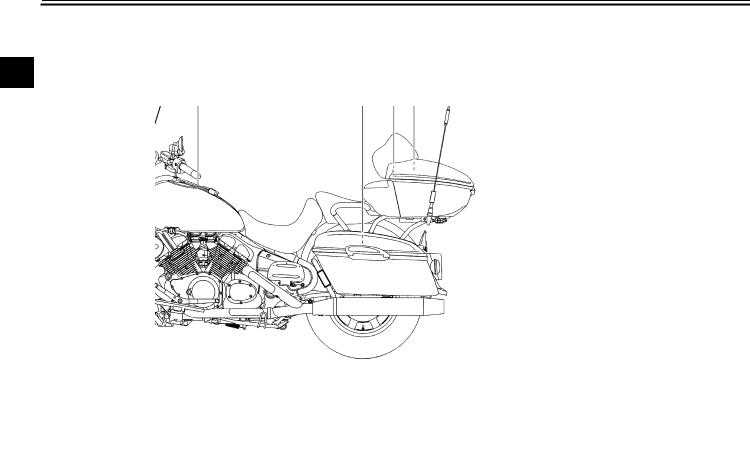
LOCATION OF IMPORTANT LABELS
EAU10383
Read and understand all of the labels on your vehicle. They contain important information for safe and proper operation of
1your vehicle. Never remove any labels from your vehicle. If a label becomes difficult to read or comes off, a replacement label is available from your Yamaha dealer.
1-1
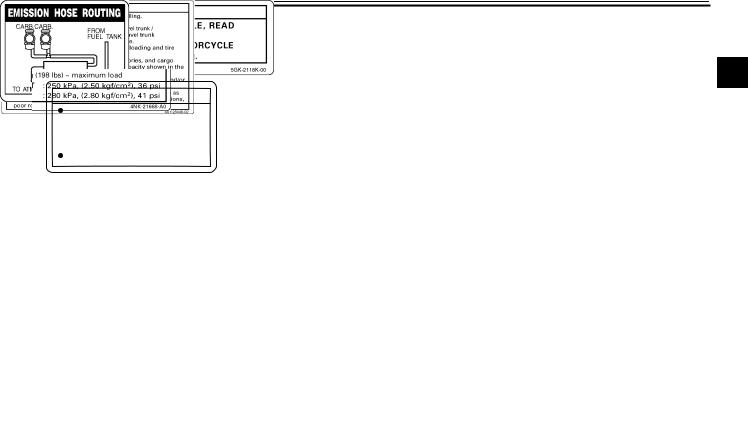
LOCATION OF IMPORTANT LABELS
1
NOTICE
Cleaning with alkaline or acid cleaner, gasoline or solvent will damage windshield.
Use neutral detergent.
4B5-2815K-00
3
1
2
4 CALIFORNIA ONLY
5
1-2

 SAFETY INFORMATION
SAFETY INFORMATION
EAU10283
Be a Responsible Owner
As the vehicle’s owner, you are responsible for the safe and proper operation
2of your motorcycle.
Motorcycles are single-track vehicles. Their safe use and operation are dependent upon the use of proper riding techniques as well as the expertise of the operator. Every operator should know the following requirements before riding this motorcycle.
He or she should:
●Obtain thorough instructions from a competent source on all aspects of motorcycle operation.
●Observe the warnings and maintenance requirements in this Owner’s Manual.
●Obtain qualified training in safe and proper riding techniques.
●Obtain professional technical service as indicated in this Owner’s Manual and/or when made necessary by mechanical conditions.
Safe Riding
Perform the pre-operation checks each time you use the vehicle to make sure it is in safe operating condition. Failure to inspect or maintain the vehicle properly increases the possibility of an accident or equipment damage. See page 6-1 for a list of pre-operation checks.
●This motorcycle is designed to carry the operator and a passenger.
●The failure of motorists to detect and recognize motorcycles in traffic is the predominating cause of automobile/motorcycle accidents. Many accidents have been caused by an automobile driver who did not see the motorcycle. Making yourself conspicuous appears to be very effective in reducing the chance of this type of accident.
Therefore:
•Wear a brightly colored jacket.
•Use extra caution when you are approaching and passing through intersections, since intersections are the most likely places for motorcycle accidents to occur.
•Ride where other motorists can see you. Avoid riding in another motorist’s blind spot.
●Many accidents involve inexperienced operators. In fact, many operators who have been involved in accidents do not even have a current motorcycle license.
•Make sure that you are qualified and that you only lend your motorcycle to other qualified operators.
•Know your skills and limits. Staying within your limits may help you to avoid an accident.
•We recommend that you practice riding your motorcycle where there is no traffic until you have become thoroughly familiar with the motorcycle and all of its controls.
●Many accidents have been caused by error of the motorcycle operator. A typical error made by the operator is veering wide on a turn
2-1

 SAFETY INFORMATION
SAFETY INFORMATION
due to excessive speed or undercornering (insufficient lean angle for the speed).
•Always obey the speed limit and never travel faster than warranted by road and traffic conditions.
•Always signal before turning or changing lanes. Make sure that other motorists can see you.
●The posture of the operator and passenger is important for proper control.
•The operator should keep both hands on the handlebar and both feet on the operator footrests during operation to maintain control of the motorcycle.
•The passenger should always hold onto the operator, the seat strap or grab bar, if equipped, with both hands and keep both feet on the passenger footrests. Never carry a passenger unless he or she can firmly place both feet on the passenger footrests.
●Never ride under the influence of alcohol or other drugs.
●This motorcycle is designed for onroad use only. It is not suitable for off-road use.
Protective apparel
The majority of fatalities from motorcycle accidents are the result of head injuries. The use of a safety helmet is the single most critical factor in the prevention or reduction of head injuries.
●Always wear an approved helmet.
●Wear a face shield or goggles. Wind in your unprotected eyes could contribute to an impairment of vision that could delay seeing a hazard.
●The use of a jacket, heavy boots, trousers, gloves, etc., is effective in preventing or reducing abrasions or lacerations.
●Never wear loose-fitting clothes, otherwise they could catch on the control levers, footrests, or wheels and cause injury or an accident.
●Always wear protective clothing that covers your legs, ankles, and feet. The engine or exhaust system become very hot during or after operation and can cause burns.
2-2
●A passenger should also observe the above precautions.
Avoid Carbon Monoxide Poisoning
All engine exhaust contains carbon monoxide, a deadly gas. Breathing car- 2 bon monoxide can cause headaches, dizziness, drowsiness, nausea, confusion, and eventually death.
Carbon Monoxide is a colorless, odorless, tasteless gas which may be present even if you do not see or smell any engine exhaust. Deadly levels of carbon monoxide can collect rapidly and you can quickly be overcome and unable to save yourself. Also, deadly levels of carbon monoxide can linger for hours or days in enclosed or poorly ventilated areas. If you experience any symptoms of carbon monoxide poisoning, leave the area immediately, get fresh air, and SEEK MEDICAL TREATMENT.
●Do not run engine indoors. Even if you try to ventilate engine exhaust with fans or open windows and doors, carbon monoxide can rapidly reach dangerous levels.

 SAFETY INFORMATION
SAFETY INFORMATION
●Do not run engine in poorly ventilated or partially enclosed areas such as barns, garages, or carports.
●Do not run engine outdoors where
2engine exhaust can be drawn into a building through openings such as windows and doors.
Loading
Adding accessories or cargo to your motorcycle can adversely affect stability and handling if the weight distribution of the motorcycle is changed. To avoid the possibility of an accident, use extreme caution when adding cargo or accessories to your motorcycle. Use extra care when riding a motorcycle that has added cargo or accessories. Here, along with the information about accessories below, are some general guidelines to follow if loading cargo to your motorcycle:
The total weight of the operator, passenger, accessories and cargo must not exceed the maximum load limit.
Operation of an overloaded vehicle could cause an accident.
Maximum load:
190 kg (419 lb)
When loading within this weight limit, keep the following in mind:
●Cargo and accessory weight should be kept as low and close to the motorcycle as possible. Securely pack your heaviest items as close to the center of the vehicle as possible and make sure to distribute the weight as evenly as possible on both sides of the motorcycle to minimize imbalance or instability.
●Shifting weights can create a sudden imbalance. Make sure that accessories and cargo are securely attached to the motorcycle before riding. Check accessory mounts and cargo restraints frequently.
•Properly adjust the suspension for your load (suspension-ad- justable models only), and check the condition and pressure of your tires.
•Never attach any large or heavy items to the handlebar, front fork, or front fender. These
2-3
items, including such cargo as sleeping bags, duffel bags, or tents, can create unstable handling or a slow steering response.
●This vehicle is not designed to pull a trailer or to be attached to a sidecar.
Genuine Yamaha Accessories
Choosing accessories for your vehicle is an important decision. Genuine Yamaha accessories, which are available only from a Yamaha dealer, have been designed, tested, and approved by Yamaha for use on your vehicle.
Many companies with no connection to Yamaha manufacture parts and accessories or offer other modifications for Yamaha vehicles. Yamaha is not in a position to test the products that these aftermarket companies produce. Therefore, Yamaha can neither endorse nor recommend the use of accessories not sold by Yamaha or modifications not specifically recommended by Yamaha, even if sold and installed by a Yamaha dealer.

 SAFETY INFORMATION
SAFETY INFORMATION
Aftermarket Parts, Accessories, and Modifications
While you may find aftermarket products similar in design and quality to genuine Yamaha accessories, recognize that some aftermarket accessories or modifications are not suitable because of potential safety hazards to you or others. Installing aftermarket products or having other modifications performed to your vehicle that change any of the vehicle’s design or operation characteristics can put you and others at greater risk of serious injury or death. You are responsible for injuries related to changes in the vehicle.
Keep the following guidelines in mind, as well as those provided under “Loading” when mounting accessories.
●Never install accessories or carry cargo that would impair the performance of your motorcycle. Carefully inspect the accessory before using it to make sure that it does not in any way reduce ground clearance or cornering clearance,
limit suspension travel, steering travel or control operation, or obscure lights or reflectors.
•Accessories fitted to the handlebar or the front fork area can create instability due to improper weight distribution or aerodynamic changes. If accessories are added to the handlebar or front fork area, they must be as lightweight as possible and should be kept to a minimum.
•Bulky or large accessories may seriously affect the stability of the motorcycle due to aerodynamic effects. Wind may attempt to lift the motorcycle, or the motorcycle may become unstable in cross winds. These accessories may also cause instability when passing or being passed by large vehicles.
•Certain accessories can displace the operator from his or her normal riding position. This improper position limits the freedom of movement of the opera-
tor and may limit control ability, therefore, such accessories are not recommended.
● Use caution when adding electrical accessories. If electrical acces-
sories exceed the capacity of the 2 motorcycle’s electrical system, an electric failure could result, which could cause a dangerous loss of lights or engine power.
Aftermarket Tires and Rims
The tires and rims that came with your motorcycle were designed to match the performance capabilities and to provide the best combination of handling, braking, and comfort. Other tires, rims, sizes, and combinations may not be appropriate. Refer to page 8-21 for tire specifications and more information on replacing your tires.
2-4
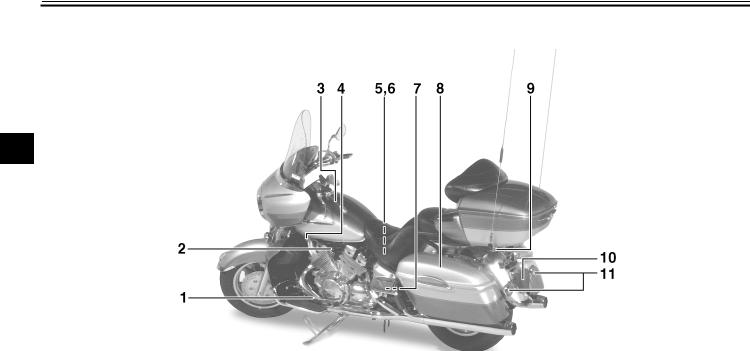
DESCRIPTION
EAU10410
Left view
3
1.Shift pedal (page 4-9)
2.Starter (choke) knob (page 4-13)
3.Fuel tank cap (page 4-10)
4.Fuel cock (page 4-12)
5.Battery (page 8-31)
6.Coolant reservoir (page 8-17)
7.Fuse box 2 (page 8-32)
8.Sidecase (page 4-15)
9. Helmet holder (page 4-15) 10.Tail/brake light (page 8-35) 11.Rear turn signal light (page 8-35)
3-1
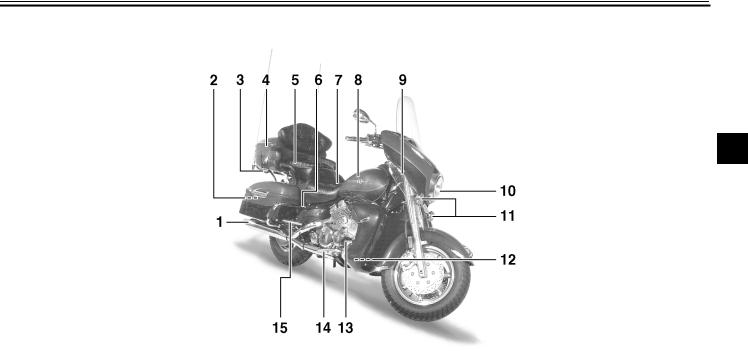
DESCRIPTION
EAU10420
Right view
3
1.Muffler
2.Owner’s tool kit (page 8-2)
3.Helmet holder (page 4-15)
4.Travel trunk (page 4-15)
5.Passenger seat
6.Shock absorber assembly air valve (page 4-18)
7.Rider seat (page 4-14)
8.Fuel tank (page 4-10)
9. Front fork air valve (page 4-17) 10.Headlight (page 8-34)
11.Front turn signal/position lights (page 8-35) 12.Fuse box 1 (page 8-32)
13.Brake pedal (page 4-10) 14.Rider footrest 15.Passenger footrest
3-2

DESCRIPTION
EAU10430
Controls and instruments
3
1. Clutch lever (page 4-9) |
9. Brake lever (page 4-10) |
2.Audio system/CB radio control unit (page 5-3)
3.Left handlebar switches (page 4-7)
4.Rider headset jack (page 5-2)
5.Speedometer unit (page 4-4)
6.Main switch/steering lock (page 4-1)
7.Right handlebar switches (page 4-7)
8.Throttle grip (page 8-20)
3-3

INSTRUMENT AND CONTROL FUNCTIONS
EAU10460
Main switch/steering lock
The main switch/steering lock controls the ignition and lighting systems, and is used to lock the steering. The various positions are described below.
EAU10510
ON
All electrical systems are supplied with power, and the headlight, meter lighting, taillight and position lights come on, and the engine can be started. The key cannot be removed.
EAU10661
OFF
All electrical systems are off. The key can be removed.
EWA10061
 WARNING
WARNING
Never turn the key to “OFF” or “LOCK” while the vehicle is moving. Otherwise the electrical systems will be switched off, which may result in loss of control or an accident.
EAU10691
LOCK
The steering is locked, and all electrical systems are off. The key can be removed.
To lock the steering
1.Push.
2.Turn.
1.Turn the handlebars all the way to the left or right.
2.Push the key in from the “OFF” position, and then turn it to “LOCK” while still pushing it.
3.Remove the key.
To unlock the steering
4
1.Push.
2.Turn.
Push the key into the main switch, and then turn it to “OFF” while still pushing it.
EAU10951
ACC (Accessory)
The audio system and the auxiliary DC jack and connector can be used in this position. Do not use the accessory position for an extended period of time, otherwise the battery may discharge.
4-1

INSTRUMENT AND CONTROL FUNCTIONS
The key cannot be removed. |
EAU11003 |
|
Indicator and warning lights |
4
1. Left turn signal indicator light “ ”
”
2. High beam indicator light “  ” 3. Oil level warning light “
” 3. Oil level warning light “ 

 ” 4. Overdrive indicator light “O/D”
” 4. Overdrive indicator light “O/D”
5. Engine trouble warning light “  ”
”
6. Fuel level warning light “ ”
”
1.Cruise control indicator lights
2.Right turn signal indicator light “ ”
”
3.Neutral indicator light “  ”
”
4.Coolant temperature warning light “  ”
”
EAU11030
Turn signal indicator lights “ ” and “
” and “ ”
”
The corresponding indicator light flashes when the turn signal switch is pushed to the left or right.
EAU11060
Neutral indicator light “ ”
”
This indicator light comes on when the transmission is in the neutral position.
4-2

INSTRUMENT AND CONTROL FUNCTIONS
EAU11080
High beam indicator light “ ”
”
This indicator light comes on when the high beam of the headlight is switched on.
EAU11141
Oil level warning light “

 ”
”
This warning light comes on if the engine oil level is low.
The electrical circuit of the warning light can be checked according to the following procedure.
1.Set the engine stop switch to “ ” and turn the key to “ON”.
” and turn the key to “ON”.
2.Shift the transmission into the neutral position or pull the clutch lever.
3.Push the start switch. If the warning light does not come on while pushing the start switch, have a Yamaha dealer check the electrical circuit.
TIP
Even if the oil level is sufficient, the warning light may flicker when riding on a slope or during sudden acceleration or deceleration, but this is not a malfunction.
EAU11270
Fuel level warning light “ ”
”
This warning light comes on when the fuel level drops below approximately 3.5 L (0.92 US gal, 0.77 Imp.gal). When this occurs, turn the fuel cock lever to the “RES” position and refuel as soon as possible.
EAU11380
Cruise control indicator lights
See page 4-5 for an explanation of these indicator lights.
EAU11412
Coolant temperature warning light “  ”
”
This warning light comes on if the engine overheats. If this occurs, stop the engine immediately and allow the engine to cool.
The electrical circuit of the warning light can be checked according to the following procedure.
1.Set the engine stop switch to “ ” and turn the key to “ON”.
” and turn the key to “ON”.
2.Shift the transmission into the neutral position or pull the clutch lever.
3.Push the start switch. If the warning light does not come on while pushing the start switch, have a Yamaha dealer check the electrical circuit.
ECA10021
NOTICE
Do not continue to operate the engine if it is overheating.
TIP |
|
4 |
|
●For radiator-fan-equipped vehicles, the radiator fan(s) automatically switch on or off according to the coolant temperature in the radiator.
●If the engine overheats, see page 8-37 for further instructions.
EAU11450
Overdrive indicator light “O/D”
This indicator light comes on when the transmission is in overdrive (5th gear).
EAU11503
Engine trouble warning light “  ”
”
This warning light comes on or flashes if a problem is detected in the electrical circuit monitoring the engine. If this oc-
4-3

INSTRUMENT AND CONTROL FUNCTIONS
curs, have a Yamaha dealer check the self-diagnosis system. (See page 4-7 for an explanation of the self-diagnosis device.)
The electrical circuit of the warning light can be checked by turning the key to “ON”. If the warning light does not come on for a few seconds, then go off, have a Yamaha dealer check the electrical circuit.
4
EAU36401
Speedometer unit
1.Speedometer
2.Odometer/tripmeter/fuel reserve tripmeter/clock
3.“RESET” button
4.“SELECT” button
5.Fuel meter
The speedometer unit is equipped with the following:
●a digital speedometer (which shows riding speed)
●an odometer (which shows the total distance traveled)
●two tripmeters (which show the distance traveled since they were last set to zero)
●a fuel reserve tripmeter (which shows the distance traveled on the fuel reserve)
4-4
●a clock
●a fuel meter
Odometer and tripmeter modes
Pushing the “SELECT” button switches the display between the odometer mode “ODO” and the tripmeter modes “TRIP 1” and “TRIP 2” in the following order:
ODO → TRIP 1 → TRIP 2 → ODO
If the fuel level warning light comes on (see page 4-2), the odometer display will automatically change to the fuel reserve tripmeter mode “TRIP F” and start counting the distance traveled from that point. In that case, pushing the “SELECT” button switches the display between the various tripmeter and odometer modes in the following order: TRIP F → TRIP 1 → TRIP 2 → ODO → TRIP F
To reset a tripmeter, select it by pushing the “SELECT” button, and then push the “RESET” button. If you do not reset the fuel reserve tripmeter manually, it will reset itself automatically and the display will return to “TRIP 1” after refueling and traveling 5 km (3 mi).

INSTRUMENT AND CONTROL FUNCTIONS
TIP
After resetting the fuel reserve tripmeter, the display will return to the prior mode.
Clock mode
To change the display to the clock mode, push the “SELECT” button for at least two seconds.
To change the display back to the odometer and tripmeter modes, push the “SELECT” button.
To set the clock:
1.Push both the “SELECT” and “RESET” buttons for at least two seconds.
2.When the hour digits start flashing, push the “RESET” button to set the hours.
3.Push the “SELECT” button, and the minute digits will start flashing.
4.Push the “RESET” button to set the minutes.
5.Push the “SELECT” button to start the clock.
TIP
After setting the clock, be sure to push the “SELECT” button before turning the key to “OFF”, otherwise the clock will not be set.
Fuel meter
The fuel meter indicates the amount of fuel in the fuel tank. The display segments of the fuel meter disappear towards “E” (Empty) as the fuel level decreases. When only one segment is left near “E” (Empty), refuel as soon as possible. When the key is turned to “ON”, all of the display segments of the fuel meter will appear one after the other and then disappear in order to test the electrical circuit.
TIP
This fuel meter is equipped with a selfdiagnosis system. If a problem is detected in the electrical circuit, all the display segments will start flashing. If this occurs, have a Yamaha dealer check the electrical circuit.
EAU11840
Cruise control system
4
1. “CRUISE” switch
This model is equipped with a cruise control system designed to maintain a set traveling speed.
Activating and setting the cruise control system
The cruise control system can only be activated when riding in 4th or 5th gear at speeds between 50 km/h (30 mi/h) and 130 km/h (80 mi/h).
To activate and set the cruise control system:
1.Push the “CRUISE” switch to the left. The “ON” indicator light will come on.
4-5

INSTRUMENT AND CONTROL FUNCTIONS
1. Cruise control switch
42. “CANCEL” switch
2.Press the “SET/DEC” (set/decelerate) side of the cruise control switch to activate the cruise control system. The “SET” indicator light comes on.
3.Set the desired traveling speed as follows. Press the “RES/ACC” (resume/accelerate) side of the cruise control switch to increase the set speed or the “SET/DEC” side to decrease the speed.
1.“SET” indicator light
2.“RES” indicator light
3.“ON” indicator light
TIP
Pressing the cruise control switch once will change the speed in increments of 1.6 km/h (1 mi/h). Holding the cruise control switch down will increase or decrease the speed continuously until the switch is released.
The traveling speed can be set to a maximum of 130 km/h (80 mi/h) and a minimum of 50 km/h (30 mi/h).
When the cruise control system is activated and the throttle grip is turned to increase the speed by up to 8 km/h (5 mi/h), the cruise control system will return to the set speed after the throttle
grip is released. However, if the speed is increased by more than 8 km/h (5 mi/h), the cruise control system will be deactivated until the traveling speed is within 8 km/h (5 mi/h) of the set speed.
Deactivating the cruise control system
Applying the front or rear brake or disengaging the clutch will automatically deactivate the cruise control system.
Push the “CANCEL” switch to manually deactivate cruise control.
TIP
●When the cruise control system is deactivated, the “RES” (resume) indicator light will come on.
●Traveling speed decreases as soon as the cruise control system is deactivated; unless the throttle grip is turned.
Push the “RES/ACC” side of the cruise control switch to reactivate the system. The traveling speed will return to the previously set speed. The “RES” indicator light will flash during this time and
4-6
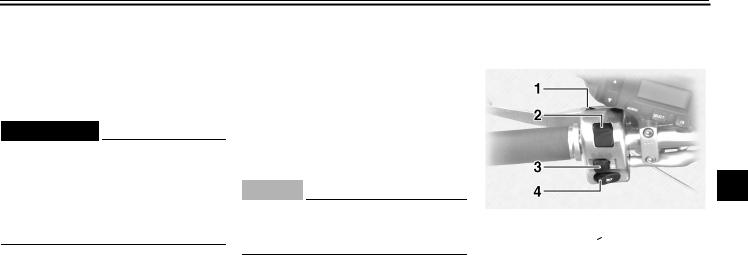
INSTRUMENT AND CONTROL FUNCTIONS
then go off. Once the cruise control system is reactivated, the “SET” indicator light will come on.
Push the “CRUISE” switch to the right to turn the cruise control system off completely.
EWA11070
 WARNING
WARNING
If the cruise control system is defective, the “SET” and “RES” indicator lights will flash simultaneously. If this occurs, turn the cruise control system off and have a Yamaha dealer check it.
EAU12092
Self-diagnosis device
This model is equipped with a self-diag- nosis device for various electrical circuits.
If a problem is detected in any of those circuits, the engine trouble warning light will come on or flash. If this occurs, have a Yamaha dealer check the vehicle.
ECA11170
NOTICE
To prevent engine damage, be sure to consult a Yamaha dealer as soon as possible if this occurs.
EAU12347
Handlebar switches
Left
4
1.“TALK” switch
2.Dimmer switch “  /
/ ”
”
3.Turn signal switch “ /
/ ”
”
4.Horn switch “  ”
”
4-7

INSTRUMENT AND CONTROL FUNCTIONS
Right
41. Engine stop switch “ /
/ ”
”
2.Hazard switch “ ”
”
3.Cruise control switch
4.Start switch “ ”
”
EAU12390
“TALK” switch
See page 5-16 for an explanation of the CB radio.
EAU12400
Dimmer switch “ /
/ ”
”
Set this switch to “ ” for the high beam and to “
” for the high beam and to “ ” for the low beam.
” for the low beam.
EAU12430
Turn signal switch “ /
/ ”
”
To signal a right-hand turn, push this switch to “ ”. To signal a left-hand turn, push this switch to “
”. To signal a left-hand turn, push this switch to “ ”. When released, the switch returns to the center position.
”. When released, the switch returns to the center position.
Since this model is equipped with a self-canceling system, the turn signal lights will self-cancel after the vehicle has traveled both about 150 m (490 ft) and for approximately 15 seconds. However, the turn signal lights can also be canceled manually by pushing the switch in after it has returned to the center position.
TIP
The self-canceling system only operates when the vehicle is moving, so that the turn signal lights will not self-cancel while you are stopped at an intersection.
EAU12500
Horn switch “  ”
”
Press this switch to sound the horn.
EAU12660
Engine stop switch “ /
/ ”
”
Set this switch to “ ” before starting the engine. Set this switch to “
” before starting the engine. Set this switch to “ ” to stop the engine in case of an emergency, such as when the vehicle overturns or when the throttle cable is stuck.
” to stop the engine in case of an emergency, such as when the vehicle overturns or when the throttle cable is stuck.
EAU12711
Start switch “ ”
”
Push this switch to crank the engine with the starter. See page 7-1 for starting instructions prior to starting the engine.
EAU42390
The oil level warning light and coolant temperature warning light will come on when the key is turned to “ON” and the start switch is pushed, but this does not indicate a malfunction.
EAU12765
Hazard switch “ ”
”
With the key in the “ON” position, use this switch to turn on the hazard lights (simultaneous flashing of all turn signal lights).
4-8

INSTRUMENT AND CONTROL FUNCTIONS
The hazard lights are used in case of |
EAU12820 |
|
an emergency or to warn other drivers |
Clutch lever |
|
|
when your vehicle is stopped where it |
|
might be a traffic hazard. |
|
ECA10061 |
|
NOTICE
Do not use the hazard lights for an extended length of time with the engine not running, otherwise the battery may discharge.
EAU12780
Cruise control switches
See page 4-5 for an explanation of the cruise control system.
1. Clutch lever
The clutch lever is located at the left handlebar grip. To disengage the clutch, pull the lever toward the handlebar grip. To engage the clutch, release the lever. The lever should be pulled rapidly and released slowly for smooth clutch operation.
The clutch lever is equipped with a clutch switch, which is part of the ignition circuit cut-off system. (See page 4-20.)
EAU12880
Shift pedal
4
1. Shift pedal
The shift pedal is located on the left side of the engine and is used in combination with the clutch lever when shifting the gears of the 5-speed con- stant-mesh transmission equipped on this motorcycle.
TIP
Use your toes or heel to shift up and your toes to shift down.
4-9

INSTRUMENT AND CONTROL FUNCTIONS
EAU12890
Brake lever
4
1. Brake lever
The brake lever is located at the right handlebar grip. To apply the front brake, pull the lever toward the handlebar grip.
EAU12941
Brake pedal
1. Brake pedal
The brake pedal is on the right side of the motorcycle. To apply the rear brake, press down on the brake pedal.
EAU13121
Fuel tank cap
1.Fuel tank cap lock cover
2.Unlock.
To remove the fuel tank cap
Slide the lock cover open, insert the key into the lock, and then turn it 1/4 turn clockwise. The lock will be released and the fuel tank cap can be removed.
To install the fuel tank cap
1.Insert the fuel tank cap into the tank opening with the key inserted
in the lock and with the “ ” mark facing forward.
” mark facing forward.
2.Turn the key counterclockwise to the original position, remove it, and then close the lock cover.
4-10

INSTRUMENT AND CONTROL FUNCTIONS
TIP
The fuel tank cap cannot be installed unless the key is in the lock. In addition, the key cannot be removed if the cap is not properly installed and locked.
EWA10131
 WARNING
WARNING
Make sure that the fuel tank cap is properly installed before riding. Leaking fuel is a fire hazard.
EAU13212
Fuel
Make sure there is sufficient gasoline in the tank.
EWA10881
 WARNING
WARNING
Gasoline and gasoline vapors are extremely flammable. To avoid fires and explosions and to reduce the risk of injury when refueling, follow these instructions.
1.Before refueling, turn off the engine and be sure that no one is sitting on the vehicle. Never refuel while smoking, or while in the vicinity of sparks, open flames, or other sources of ignition such as the pilot lights of water heaters and clothes dryers.
2.Do not overfill the fuel tank. Stop filling when the fuel reaches the bottom of the filler tube. Because fuel expands when it heats up, heat from the engine or the sun can cause fuel to spill out of the fuel tank.
1. |
Fuel tank filler tube |
|
4 |
|
2. |
Fuel level |
|
|
|
|
|
|
|
|
3.Wipe up any spilled fuel immediately. NOTICE: Immediately wipe off spilled fuel with a clean, dry, soft cloth, since fuel may deteriorate painted surfaces or plastic
parts. [ECA10071]
4.Be sure to securely close the fuel tank cap.
EWA15151
 WARNING
WARNING
Gasoline is poisonous and can cause injury or death. Handle gasoline with care. Never siphon gasoline by mouth. If you should swallow some gasoline or inhale a lot of gasoline vapor, or get some gasoline in your eyes, see your doctor immedi-
4-11

INSTRUMENT AND CONTROL FUNCTIONS
ately. If gasoline spills on your skin, wash with soap and water. If gasoline spills on your clothing, change your clothes.
EAU13301
|
|
|
|
Recommended fuel: |
||
|
|
|
|
UNLEADED GASOLINE ONLY |
||
|
|
|
|
Fuel tank capacity: |
||
|
4 |
|
||||
|
|
|
22.5 L (5.94 US gal, 4.95 Imp.gal) |
|||
|
|
|
|
|||
|
|
|
|
Fuel reserve amount: |
||
|
|
|
||||
|
|
|
|
3.5 L (0.92 US gal, 0.77 Imp.gal) |
||
|
|
|
|
|
|
|
|
|
|
|
|
|
ECA11400 |
|
|
|
|
NOTICE |
|
|
|
|
|
|
Use only unleaded gasoline. The use |
||
|
|
|
|
of leaded gasoline will cause severe |
||
|
|
|
|
damage to internal engine parts, |
||
|
|
|
|
such as the valves and piston rings, |
||
|
|
|
|
as well as to the exhaust system. |
||
Your Yamaha engine has been designed to use regular unleaded gasoline with a pump octane number [(R+M)/2] of 86 or higher, or a research octane number of 91 or higher. If knocking (or pinging) occurs, use a gasoline of a different brand or premi-
um unleaded fuel. Use of unleaded fuel will extend spark plug life and reduce maintenance costs.
Gasohol
There are two types of gasohol: gasohol containing ethanol and that containing methanol. Gasohol containing ethanol can be used if the ethanol content does not exceed 10% (E10). Gasohol containing methanol is not recommended by Yamaha because it can cause damage to the fuel system or vehicle performance problems.
EAU13550
Fuel cock
The fuel cock supplies fuel from the tank to the carburetors while also filtering it.
The fuel cock lever positions are explained as follows and shown in the illustrations.
OFF
1. Pointed end positioned over “OFF”
With the fuel cock lever in this position, fuel will not flow. Always turn the fuel cock lever to this position when the engine is not running.
4-12
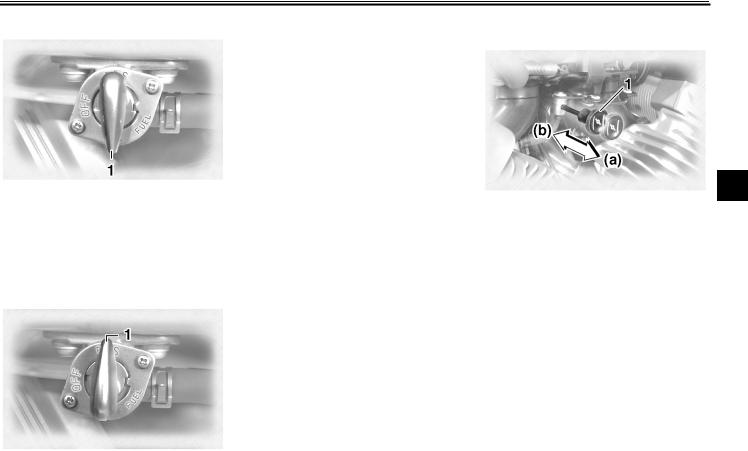
INSTRUMENT AND CONTROL FUNCTIONS
ON |
This indicates reserve. With the fuel |
|
cock lever in this position, the fuel re- |
|
serve is made available. Turn the fuel |
|
cock lever to this position if you run out |
|
of fuel while riding. When this occurs, |
|
refuel as soon as possible and be sure |
|
to turn the fuel cock lever back to “ON”! |
EAU13600
Starter (choke) knob “ 

 ”
”
1. Pointed end positioned over “ON”
With the fuel cock lever in this position, fuel flows to the carburetors. Turn the fuel cock lever to this position when starting the engine and riding.
RES
4
1. Starter (choke) knob “ 

 ”
”
Starting a cold engine requires a richer air-fuel mixture, which is supplied by the starter (choke).
Move the knob in direction (a) to turn on the starter (choke).
Move the knob in direction (b) to turn off the starter (choke).
1. Pointed end positioned over “RES”
4-13

INSTRUMENT AND CONTROL FUNCTIONS
EAU13780 |
EAU14240 |
Locking the steering with a |
Rider seat |
padlock |
To remove the rider seat |
|
|
|
Remove the nuts, and then pull the rid- |
|
er seat up. |
4
In addition to the main switch/steering lock, there are brackets on the right side of the steering head pipe for locking the steering with a padlock. To do so, turn the handlebar until the holes in the two brackets are aligned, and then lock the steering with a suitable padlock.
1. Projection
2. Seat holder
TIP
Make sure that the rider seat is properly
secured before riding.
1. Nut
To install the rider seat
Insert the projection on the rear of the rider seat into the seat holder as shown, place the seat in the original position, and then tighten the nuts.
4-14
